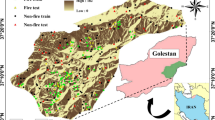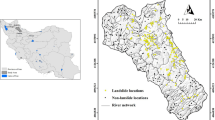Abstract
Forest fire prediction is the most significant component of forest fire management. It is necessary because it plays an important role in resource management and recovery efforts. So, in order to model and predict such a calamity, advanced computing technologies are needed. This paper describes a detailed analysis of forest fire prediction methods based on Artificial Neural Network and Genetic algorithm (GA). The objective is to analyse forest fire prediction in Kerala, India. This paper describes Feed Forward–Back Propagation (FFBP) algorithm to train the networks; to get optimised results, GA is used. Promising results are obtained for GA approach than ANN alone.
Access this chapter
Tax calculation will be finalised at checkout
Purchases are for personal use only
Similar content being viewed by others
References
Somashekar, R.K., Ravikumar, P., Mohan Kumar, C.N., Prakash, K.L., Nagaraja, B.C.: Burnt area mapping of Bandipur National Park, India using IRS 1C/1D LISS III data. J. Indian Soc. Rem. Sens. 37(1), 37–50 (2009)
Tatli, H., Türkeş, M.: Climatological evaluation of H aines forest fire weather index over the Mediterranean B asin. Meteorol. Appl. 21(3), 545–552 (2014)
Lazaridis, M., Latos, M., Aleksandropoulou, V., Hov, Ø., Papayannis, A., Tørseth, K.: Contribution of forest fire emissions to atmospheric pollution in Greece. Air Qual. Atmos. Health 1, 14–158 (2008)
Dawson, T.P., Butt, N., Miller, F.: The ecology of forest fires. ASEAN Biodiv. 1(3), 18–21 (2001)
Podur, J.J., Martell, D.L.: The influence of weather and fuel type on the fuel composition of the area burned by forest fires in Ontario. Ecol. Appl. 19, 1246–1252 (2006)
Roy, P.S: Forest fire and degradation assessment using satellite remote sensing and geographic information system. Satell. Rem. Sen. GIS Appl. Agric. Meteorol. 361–400 (2003). World Meteorological Organization, Switzerland
Eskandari, S., Ghadikolaei, J.O., Jalilvand, H., Saradjian, M.R.: Detection of fire high-risk areas in northern forests of Iran using Dong model. World Appl. Sci. J. 27(6), 770–773 (2013)
Ajin, R.S., Ciobotaru, A., Vinod, P.G., Jacob, M.K.: Forest and wildland fire risk assessment using geospatial techniques: a case study of Nemmara forest division, Kerala, India. J. Wetlands Biodivers. 5, 29–37 (2015)
Veeraanarayanaa, B., Ravikumar, S.K.: Assessing fire risk in forest ranges of Guntur District, Andhra Pradesh: using integrated remote sensing and GIS. Int. J. Sci. Res. 3(6), 1328–1332 (2014)
Rajabi, M., Alesheikh, A., Chehreghan, A., Gazmeh, H.: An innovative method for forest fire risk zoning map using fuzzy inference system and GIS. Int. J. Sci. Technol. Res. 2(12), 57–64 (2013)
Singh, R.P., Ajay, K.: Fire risk assessment in Chitrakoot area, Satna MP, India. Res. J. Agric. Forest. Sci. 1(5), 1–4 (2013)
Gangapriya, P., Indulekha, K.P.: Development of GIS based disaster risk information system for decision making. Int. J. Innov. Res. Sci. Eng. Technol. 2(Suppl. 1), 140–148(2013)
Rothermel, P., Richard, C.: A Mathematical Model for Predicting Fire Spread in Wild Land Fires. USDA Forest Service Research Paper INT – 115, Ogden, Utah, USA (1972)
Sowmya, S.V., Somashekar, R.K.: Application of remote sensing and geographical information system in mapping forest fire risk zone at Bhadra Wildlife Sanctuary, India. J. Environ. Biol. 31(6), 969–974 (2010)
Mahdavi, A., Shamsi, S.R.F., Nazari, R.: Forests and rangelands’ wildfire risk zoning using GIS and AHP techniques. Caspian J. Environ. Sci. 10(1), 43–52 (2012)
Wijayanto, A.K., Sani, O., Kartika, N.D., Herdiyeni, Y.: Classification model for forest fire hotspot occurrences prediction using ANFIS algorithm. In: IOP Conference on Series: Earth and Environmental Science, vol. 54, p. 012059 (2017)
Sakr, E., Elhajj, I.H., Mitri, G., Wejinya, U.C.: Artificial intelligence for forest fire prediction. In: International Conference on Advanced Intelligent Mechatronics Montréal, Canada, 6–9 July 2010
Safi, Y., Bouroumi, A.: Prediction of forest fires using artificial neural networks. Appl. Math. Sci. 7(6), 271–286 (2013)
Assaker, A., Darwish, T., Faour, G., Noun, M.: Use of remote sensing and GIS to assess the anthropogenic impact on forest fires in Nahr Ibrahim Watershed, Lebanon. Lebanese Sci. J. 13(1), 15–28 (2012)
Ojha, V.K., Dutta, P., Saha, H.: Performance analysis of neuro genetic algorithm applied on detecting proportion of components in manhole gas mixture. Int. J. Artif. Intell. Appl. 3(4), 83–98 (2012)
Haykin, S.S.: Neural Network a Comprehensive Foundation, 2nd edn. Pearson Prentice Hall, Upper Saddle River (2005)
Castelli, M., Vanneschi, L., Popovič, A.: Predicting burned areas of forest fires: an artificial intelligence approach. Fire Ecol. 11(1), 106–118 (2015)
Chavan, M.E., Das, K.K., Suryawanshi, R.S.: Forest fire risk zonation using remote sensing and GIS in Huynial watershed, Tehri Garhwal District, UA. Int. J. Basic Appl. Res. 2, 6–12 (2012)
Author information
Authors and Affiliations
Corresponding author
Editor information
Editors and Affiliations
Rights and permissions
Copyright information
© 2020 Springer Nature Switzerland AG
About this paper
Cite this paper
Pai, M.L., Varsha, K.S., Arya, R. (2020). Application of Artificial Neural Networks and Genetic Algorithm for the Prediction of Forest Fire Danger in Kerala. In: Abraham, A., Cherukuri, A., Melin, P., Gandhi, N. (eds) Intelligent Systems Design and Applications. ISDA 2018 2018. Advances in Intelligent Systems and Computing, vol 941. Springer, Cham. https://doi.org/10.1007/978-3-030-16660-1_91
Download citation
DOI: https://doi.org/10.1007/978-3-030-16660-1_91
Published:
Publisher Name: Springer, Cham
Print ISBN: 978-3-030-16659-5
Online ISBN: 978-3-030-16660-1
eBook Packages: Intelligent Technologies and RoboticsIntelligent Technologies and Robotics (R0)




